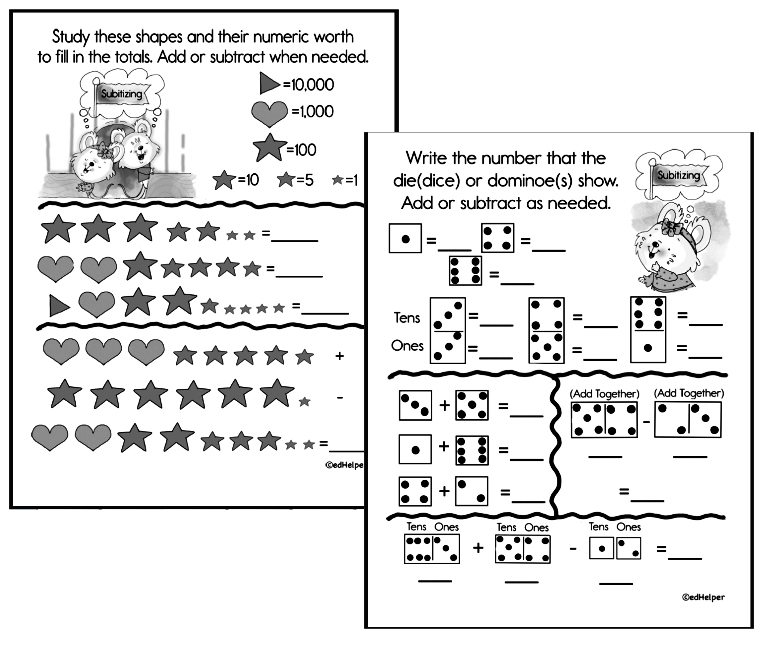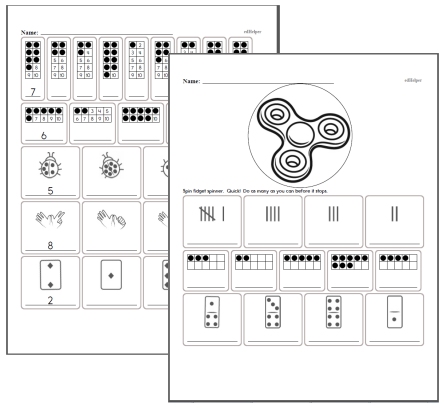Everything You Need to Know About Subitizing in Math
By: edHelper Staff
Updated: Sep 19, 2023

How to Incorporate Subitizing in Your Classroom
Math is a subject that's cumulative. Without a firm foundation, subsequent math skills become more and more difficult.
Subitizing is a skill that shouldn't be overlooked. Not only does it make adding and subtracting easier, but it also makes everything from multiplication to algebra easier as kids move on to middle school, high school, and beyond.
But, exactly what is subitizing in math? And how can you incorporate it-in fun ways!-into your classroom?
What Does It Mean to Subitize?
Every child learns one-to-one correspondence, which means that each item in a group counts for one, and it cannot be counted more than once. Children who point at items one-by-one while counting are engaging in this important foundational math skill.
But, at some point, it isn't enough. Many adults struggle with math today because they never moved away from using one-to-one correspondence. Some parents still imagine counting the imaginary dots on numbers when they help their child with math homework. Many adults can't fathom adding two-digit numbers without a calculator or carrying the one on paper.
That's where subitizing comes in.
Subitizing is the vital skill of instantly recognizing the number of objects in a group without counting them. It's what we do when we recognize the number of dots on a die or on the face of a domino.
When students learn to subitize, they are developing a deeper sense of how groups of numbers relate to each other. Instead of thinking about six as six individual numbers, and counting four more one by one to get to ten, students can see how a group of six combines with a group of four to make ten without counting.
Fun Ways for Students to Practice Subitizing in the Classroom


Easy Subitizing Worksheets
Just because you or your students know what subitizing is doesn't mean you can do it! Learning how to visualize numbers in groups takes practice. The good news is that practicing subitizing in math can be fun!
Here are five of our favorite ways to practice subitizing in the classroom and beyond:
- Play a quick game of How Many
- Get creative with 10 frames
- Play a game with dice
- Use a variety of materials
- Worksheets are a great way to practice subitizing too!
Play a quick game of How Many
This is a great activity because it can be played just before math starts, every day after recess, or even if you have a few extra minutes while the kids are waiting in line to go to art class.
Hold up your fingers in different combinations. Ask "How many?", then put your fingers down. This ensures that your students don't have time to count each finger one by one. They have to rely on subitizing to recognize the number. Students can raise their hands to be called on for the answer, or you can have them write the number down on a piece of paper.
You could also use subitizing flashcards with pictures of hands holding up fingers, dominoes, dice, or 10 frames. Flash them quickly, give students a few seconds to write down the number, then move on to the next one in rapid-fire succession. That way, they don't have time to count one by one.
Get creative with 10 frames
Ten frames are a great way to learn subitizing skills, but they can get a little boring, especially if you use them in the classroom a lot.
Make them more fun by incorporating them into games like:
- Ten Frame War is a game in which each student flips over one of the ten frames in their hand, and the child with the highest card takes both cards. The player with the most cards at the end of the game wins.
- Ten Frame Bingo uses Bingo cards with numbers in each box. A student draws a ten frame card, then must determine how many more make ten. That's the number they mark on their Bingo card.
- Ten Frame Memory is played like regular Memory, except players must match a card with a ten frame to a card with its corresponding number.
- Find a Friend is played by having each student wear a different ten frame. They must find their match by finding the student with a number on their ten frame that equals ten when they are added together.
Play a game with dice
Playing with dice is an extremely intuitive way to get kids thinking about numbers in groups! Just about any game that uses dice will work, but there are some great dice games out there that really focus on the skill of subitizing.
They include the following:
- Roll to Six requires two players to each roll one die. They must each roll until they get one. Then, they roll until they get two-the first player to roll six wins.
- Dice Bingo is like Ten Frame Bingo, except instead of pulling ten frame cards, students roll a die or dice. Then, they must mark the corresponding number on their Bingo card.
- Roll and Cover uses Bingo-like cards that are covered in dots in many different arrangements. Players roll a die and must match the corresponding arrangement by sight.
Guess the Number is an especially fun game to play with the whole class. Ask one student to place a large foam die on their head with their chosen number facing out. Once the whole class sees the number (without shouting it out loud!), the teacher guesses which number it is.
All you have to do is look at the back of the child's head. When you know what number is on the back of the die, you will always know the number on the front of the die because opposite sides of a die always equal seven! Fill your students in on the secret, and they will love practicing this trick with their friends and family.
Use a variety of materials
There are tons of different subitizing games floating around out there on the Internet, but that doesn't mean your kids need a brand-new activity every time you want to practice. It's just as much fun for students if you practice the same activities with different materials.
For example, if students are using blank ten frames to show different numbers, don't just have them place counters on cards. Make giant ten frames on the floor and have students use their shoes as counters!
Other materials that can be used in subitizing activities include:
- Rocks
- Legos
- Pom pom balls
- Snacks and candy
- Clothes pins
- Playdough
- Beads
- Stickers
- Math cubes
- Spinners
Worksheets are a great way to practice subitizing too!
Don't underestimate the power of worksheets as a way for students to practice subitizing! They can be completed during class and are an especially good early finisher activity that enables students to get a little extra practice.
The best worksheets incorporate activities and materials that make completing the worksheet fun. For example, coloring sheets are great because students have to figure out the number of dots in a section. Then, they must find the corresponding color according to the key.
EdHelper has a lot of great subitizing workbook pages that feature a wide variety of activities that are perfect for beginners and experts. Check them out here!
Tips For Subitizing Success
It's important to take things slow if you're just beginning to teach subitizing skills in your classroom. Very young students may still need to count one by one as they get the hang of recognizing numbers in groups, which means giving them more time to think.
Even older students can struggle with subitizing, so it's important to know where each of your students is at. For example, you don't want to do rapid-fire subitizing activities all the time if not all of your students have the hang of this skill. Also, playing other games that enable students to slow down and think helps prevent children who may be struggling with the concept from falling behind.
The importance of learning how to subitize cannot be overstated. Squeezing in this type of practice whenever you can, even in the upper elementary years, lays the foundation for easier arithmetic later. It's the basis for students actually feeling like they understand how math works, enabling them to build their confidence to tackle more complex math problems as they progress through school.














